Leadership, Management, and Team Dynamics: A Detailed Analysis Report
VerifiedAdded on 2020/01/28
|11
|2848
|65
Report
AI Summary
This report provides a comparative analysis of leadership and management, highlighting their distinct characteristics and illustrating their differences with examples. It delves into three leadership styles: democratic, laissez-faire, and autocratic, outlining their key features and implications. The report defines teamwork, identifies its core characteristics, and explores the roles of team leaders in fostering effective team operations. Furthermore, it defines delegation, explaining its purpose and how it contributes to smooth and effective work processes within an organization. The report draws on various sources to support its findings and concludes with recommendations for effective leadership and management practices, emphasizing the importance of aligning leadership skills with managerial expertise to drive organizational growth. The report also covers the importance of team dynamics and their influence on organizational goals.
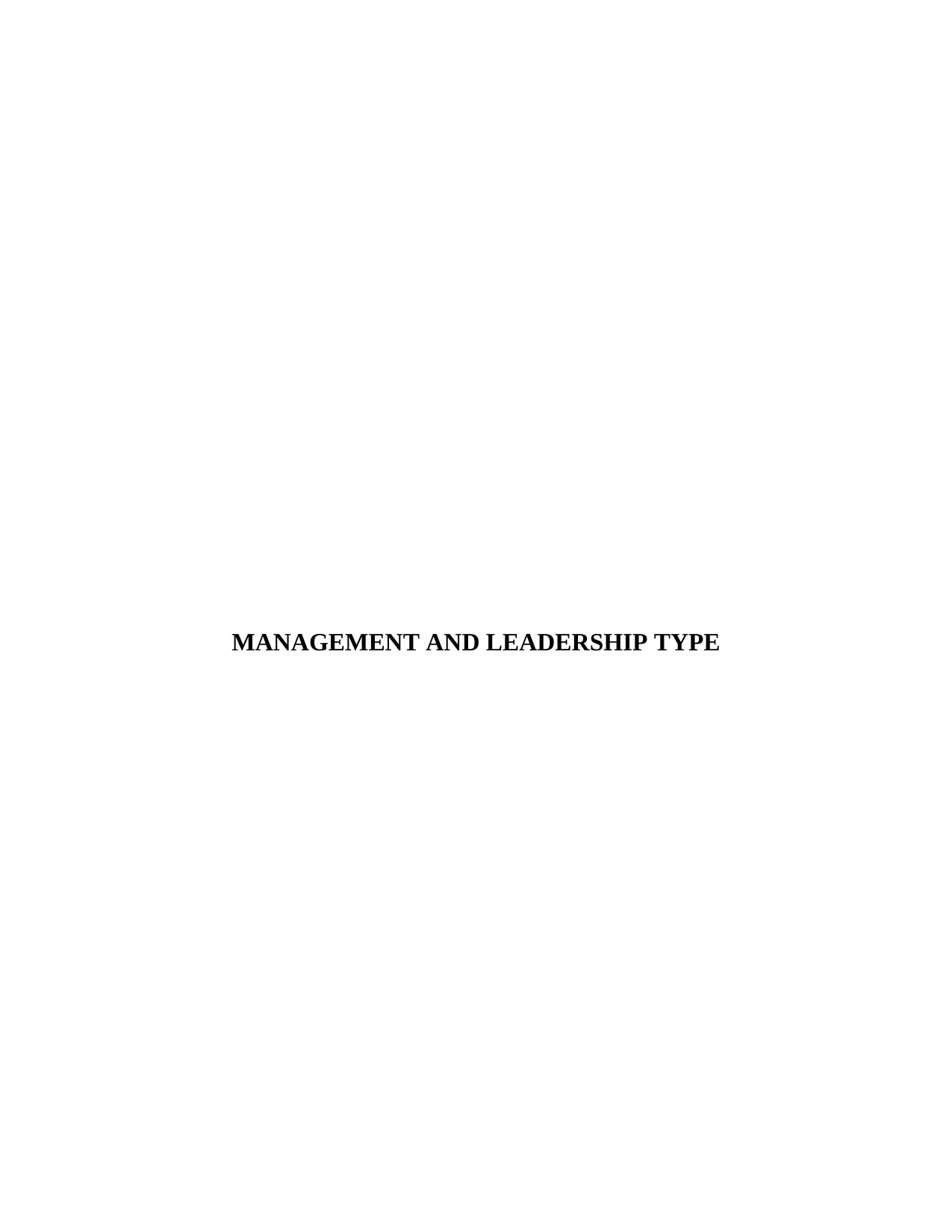
MANAGEMENT AND LEADERSHIP TYPE
Paraphrase This Document
Need a fresh take? Get an instant paraphrase of this document with our AI Paraphraser
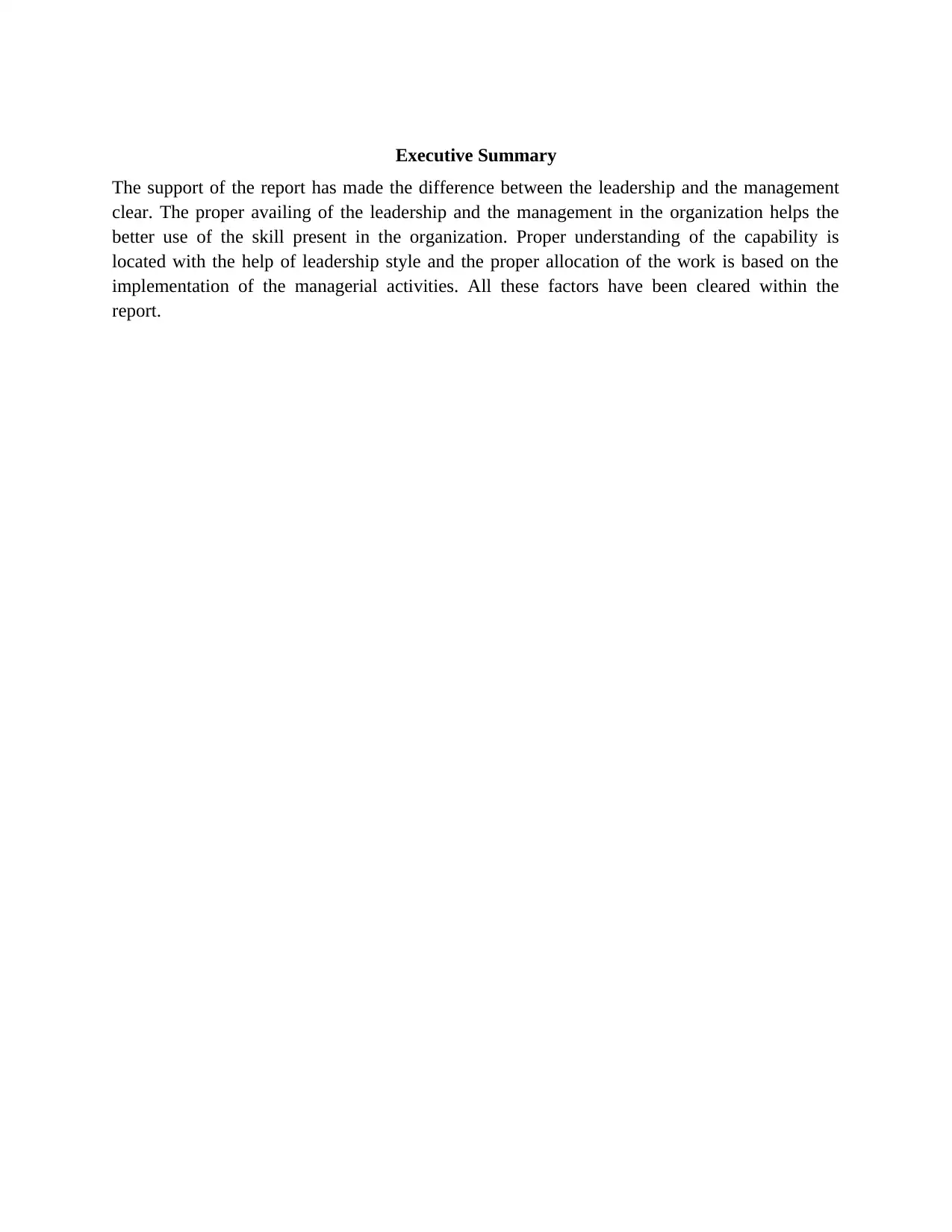
Executive Summary
The support of the report has made the difference between the leadership and the management
clear. The proper availing of the leadership and the management in the organization helps the
better use of the skill present in the organization. Proper understanding of the capability is
located with the help of leadership style and the proper allocation of the work is based on the
implementation of the managerial activities. All these factors have been cleared within the
report.
The support of the report has made the difference between the leadership and the management
clear. The proper availing of the leadership and the management in the organization helps the
better use of the skill present in the organization. Proper understanding of the capability is
located with the help of leadership style and the proper allocation of the work is based on the
implementation of the managerial activities. All these factors have been cleared within the
report.
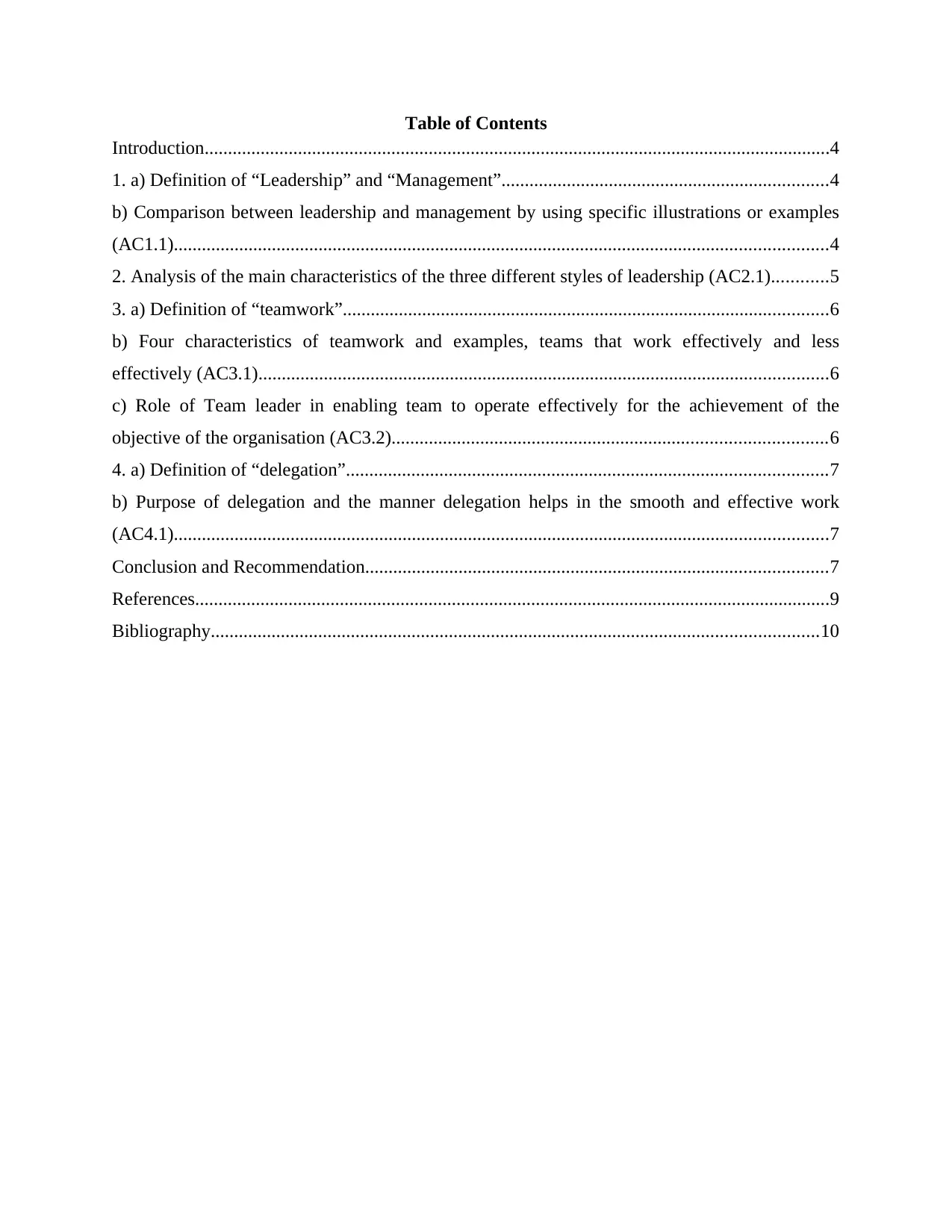
Table of Contents
Introduction......................................................................................................................................4
1. a) Definition of “Leadership” and “Management”......................................................................4
b) Comparison between leadership and management by using specific illustrations or examples
(AC1.1)............................................................................................................................................4
2. Analysis of the main characteristics of the three different styles of leadership (AC2.1)............5
3. a) Definition of “teamwork”........................................................................................................6
b) Four characteristics of teamwork and examples, teams that work effectively and less
effectively (AC3.1)..........................................................................................................................6
c) Role of Team leader in enabling team to operate effectively for the achievement of the
objective of the organisation (AC3.2).............................................................................................6
4. a) Definition of “delegation”.......................................................................................................7
b) Purpose of delegation and the manner delegation helps in the smooth and effective work
(AC4.1)............................................................................................................................................7
Conclusion and Recommendation...................................................................................................7
References........................................................................................................................................9
Bibliography..................................................................................................................................10
Introduction......................................................................................................................................4
1. a) Definition of “Leadership” and “Management”......................................................................4
b) Comparison between leadership and management by using specific illustrations or examples
(AC1.1)............................................................................................................................................4
2. Analysis of the main characteristics of the three different styles of leadership (AC2.1)............5
3. a) Definition of “teamwork”........................................................................................................6
b) Four characteristics of teamwork and examples, teams that work effectively and less
effectively (AC3.1)..........................................................................................................................6
c) Role of Team leader in enabling team to operate effectively for the achievement of the
objective of the organisation (AC3.2).............................................................................................6
4. a) Definition of “delegation”.......................................................................................................7
b) Purpose of delegation and the manner delegation helps in the smooth and effective work
(AC4.1)............................................................................................................................................7
Conclusion and Recommendation...................................................................................................7
References........................................................................................................................................9
Bibliography..................................................................................................................................10
⊘ This is a preview!⊘
Do you want full access?
Subscribe today to unlock all pages.

Trusted by 1+ million students worldwide
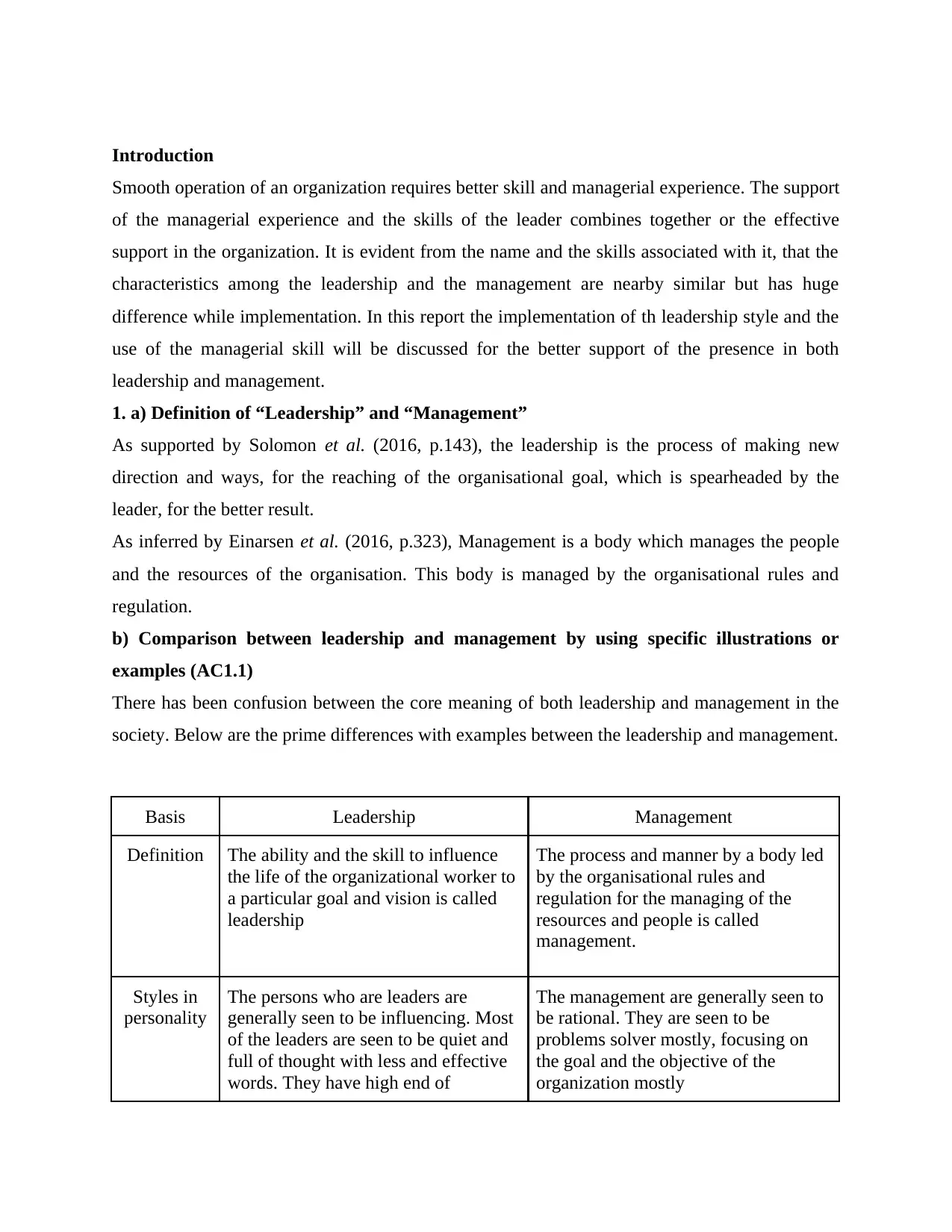
Introduction
Smooth operation of an organization requires better skill and managerial experience. The support
of the managerial experience and the skills of the leader combines together or the effective
support in the organization. It is evident from the name and the skills associated with it, that the
characteristics among the leadership and the management are nearby similar but has huge
difference while implementation. In this report the implementation of th leadership style and the
use of the managerial skill will be discussed for the better support of the presence in both
leadership and management.
1. a) Definition of “Leadership” and “Management”
As supported by Solomon et al. (2016, p.143), the leadership is the process of making new
direction and ways, for the reaching of the organisational goal, which is spearheaded by the
leader, for the better result.
As inferred by Einarsen et al. (2016, p.323), Management is a body which manages the people
and the resources of the organisation. This body is managed by the organisational rules and
regulation.
b) Comparison between leadership and management by using specific illustrations or
examples (AC1.1)
There has been confusion between the core meaning of both leadership and management in the
society. Below are the prime differences with examples between the leadership and management.
Basis Leadership Management
Definition The ability and the skill to influence
the life of the organizational worker to
a particular goal and vision is called
leadership
The process and manner by a body led
by the organisational rules and
regulation for the managing of the
resources and people is called
management.
Styles in
personality
The persons who are leaders are
generally seen to be influencing. Most
of the leaders are seen to be quiet and
full of thought with less and effective
words. They have high end of
The management are generally seen to
be rational. They are seen to be
problems solver mostly, focusing on
the goal and the objective of the
organization mostly
Smooth operation of an organization requires better skill and managerial experience. The support
of the managerial experience and the skills of the leader combines together or the effective
support in the organization. It is evident from the name and the skills associated with it, that the
characteristics among the leadership and the management are nearby similar but has huge
difference while implementation. In this report the implementation of th leadership style and the
use of the managerial skill will be discussed for the better support of the presence in both
leadership and management.
1. a) Definition of “Leadership” and “Management”
As supported by Solomon et al. (2016, p.143), the leadership is the process of making new
direction and ways, for the reaching of the organisational goal, which is spearheaded by the
leader, for the better result.
As inferred by Einarsen et al. (2016, p.323), Management is a body which manages the people
and the resources of the organisation. This body is managed by the organisational rules and
regulation.
b) Comparison between leadership and management by using specific illustrations or
examples (AC1.1)
There has been confusion between the core meaning of both leadership and management in the
society. Below are the prime differences with examples between the leadership and management.
Basis Leadership Management
Definition The ability and the skill to influence
the life of the organizational worker to
a particular goal and vision is called
leadership
The process and manner by a body led
by the organisational rules and
regulation for the managing of the
resources and people is called
management.
Styles in
personality
The persons who are leaders are
generally seen to be influencing. Most
of the leaders are seen to be quiet and
full of thought with less and effective
words. They have high end of
The management are generally seen to
be rational. They are seen to be
problems solver mostly, focusing on
the goal and the objective of the
organization mostly
Paraphrase This Document
Need a fresh take? Get an instant paraphrase of this document with our AI Paraphraser
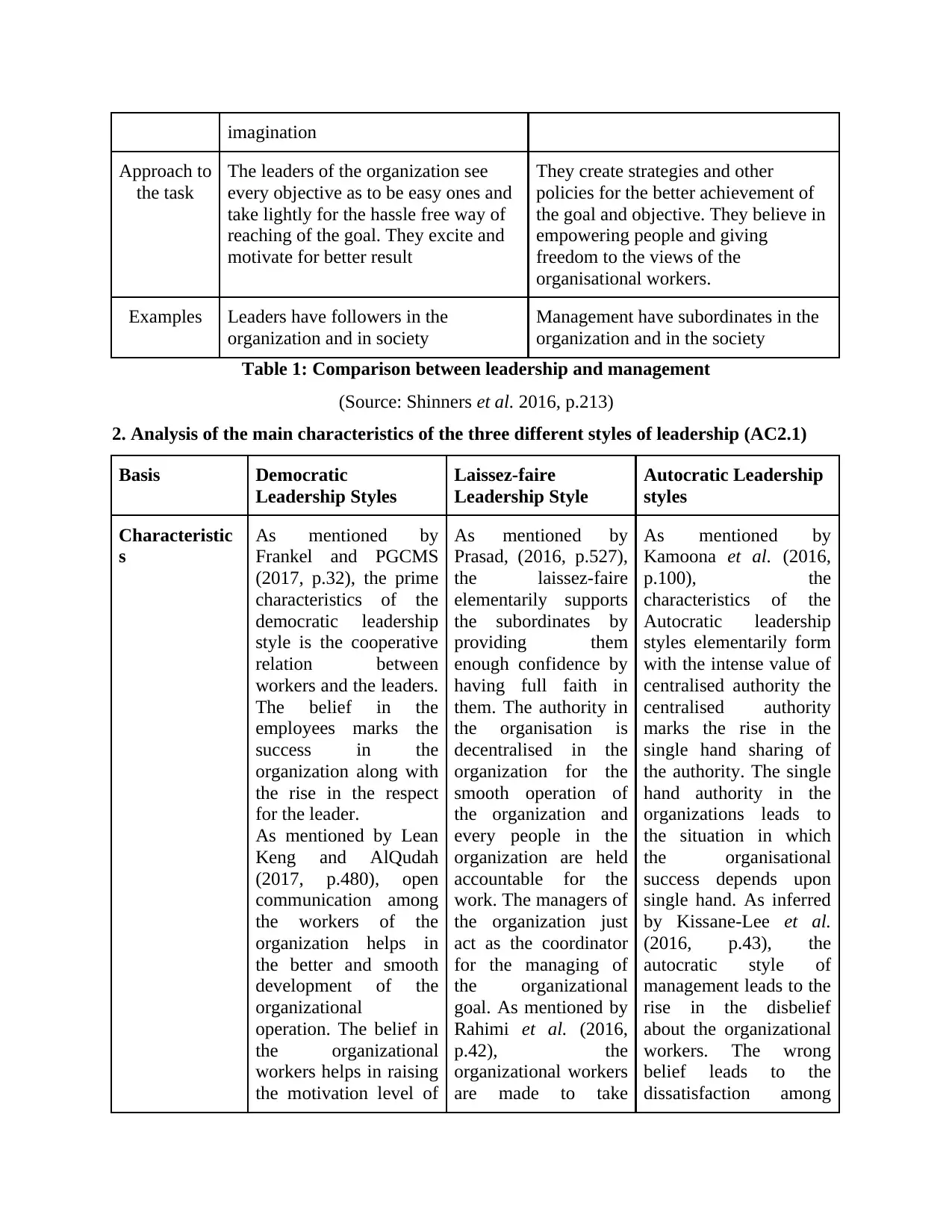
imagination
Approach to
the task
The leaders of the organization see
every objective as to be easy ones and
take lightly for the hassle free way of
reaching of the goal. They excite and
motivate for better result
They create strategies and other
policies for the better achievement of
the goal and objective. They believe in
empowering people and giving
freedom to the views of the
organisational workers.
Examples Leaders have followers in the
organization and in society
Management have subordinates in the
organization and in the society
Table 1: Comparison between leadership and management
(Source: Shinners et al. 2016, p.213)
2. Analysis of the main characteristics of the three different styles of leadership (AC2.1)
Basis Democratic
Leadership Styles
Laissez-faire
Leadership Style
Autocratic Leadership
styles
Characteristic
s
As mentioned by
Frankel and PGCMS
(2017, p.32), the prime
characteristics of the
democratic leadership
style is the cooperative
relation between
workers and the leaders.
The belief in the
employees marks the
success in the
organization along with
the rise in the respect
for the leader.
As mentioned by Lean
Keng and AlQudah
(2017, p.480), open
communication among
the workers of the
organization helps in
the better and smooth
development of the
organizational
operation. The belief in
the organizational
workers helps in raising
the motivation level of
As mentioned by
Prasad, (2016, p.527),
the laissez-faire
elementarily supports
the subordinates by
providing them
enough confidence by
having full faith in
them. The authority in
the organisation is
decentralised in the
organization for the
smooth operation of
the organization and
every people in the
organization are held
accountable for the
work. The managers of
the organization just
act as the coordinator
for the managing of
the organizational
goal. As mentioned by
Rahimi et al. (2016,
p.42), the
organizational workers
are made to take
As mentioned by
Kamoona et al. (2016,
p.100), the
characteristics of the
Autocratic leadership
styles elementarily form
with the intense value of
centralised authority the
centralised authority
marks the rise in the
single hand sharing of
the authority. The single
hand authority in the
organizations leads to
the situation in which
the organisational
success depends upon
single hand. As inferred
by Kissane-Lee et al.
(2016, p.43), the
autocratic style of
management leads to the
rise in the disbelief
about the organizational
workers. The wrong
belief leads to the
dissatisfaction among
Approach to
the task
The leaders of the organization see
every objective as to be easy ones and
take lightly for the hassle free way of
reaching of the goal. They excite and
motivate for better result
They create strategies and other
policies for the better achievement of
the goal and objective. They believe in
empowering people and giving
freedom to the views of the
organisational workers.
Examples Leaders have followers in the
organization and in society
Management have subordinates in the
organization and in the society
Table 1: Comparison between leadership and management
(Source: Shinners et al. 2016, p.213)
2. Analysis of the main characteristics of the three different styles of leadership (AC2.1)
Basis Democratic
Leadership Styles
Laissez-faire
Leadership Style
Autocratic Leadership
styles
Characteristic
s
As mentioned by
Frankel and PGCMS
(2017, p.32), the prime
characteristics of the
democratic leadership
style is the cooperative
relation between
workers and the leaders.
The belief in the
employees marks the
success in the
organization along with
the rise in the respect
for the leader.
As mentioned by Lean
Keng and AlQudah
(2017, p.480), open
communication among
the workers of the
organization helps in
the better and smooth
development of the
organizational
operation. The belief in
the organizational
workers helps in raising
the motivation level of
As mentioned by
Prasad, (2016, p.527),
the laissez-faire
elementarily supports
the subordinates by
providing them
enough confidence by
having full faith in
them. The authority in
the organisation is
decentralised in the
organization for the
smooth operation of
the organization and
every people in the
organization are held
accountable for the
work. The managers of
the organization just
act as the coordinator
for the managing of
the organizational
goal. As mentioned by
Rahimi et al. (2016,
p.42), the
organizational workers
are made to take
As mentioned by
Kamoona et al. (2016,
p.100), the
characteristics of the
Autocratic leadership
styles elementarily form
with the intense value of
centralised authority the
centralised authority
marks the rise in the
single hand sharing of
the authority. The single
hand authority in the
organizations leads to
the situation in which
the organisational
success depends upon
single hand. As inferred
by Kissane-Lee et al.
(2016, p.43), the
autocratic style of
management leads to the
rise in the disbelief
about the organizational
workers. The wrong
belief leads to the
dissatisfaction among
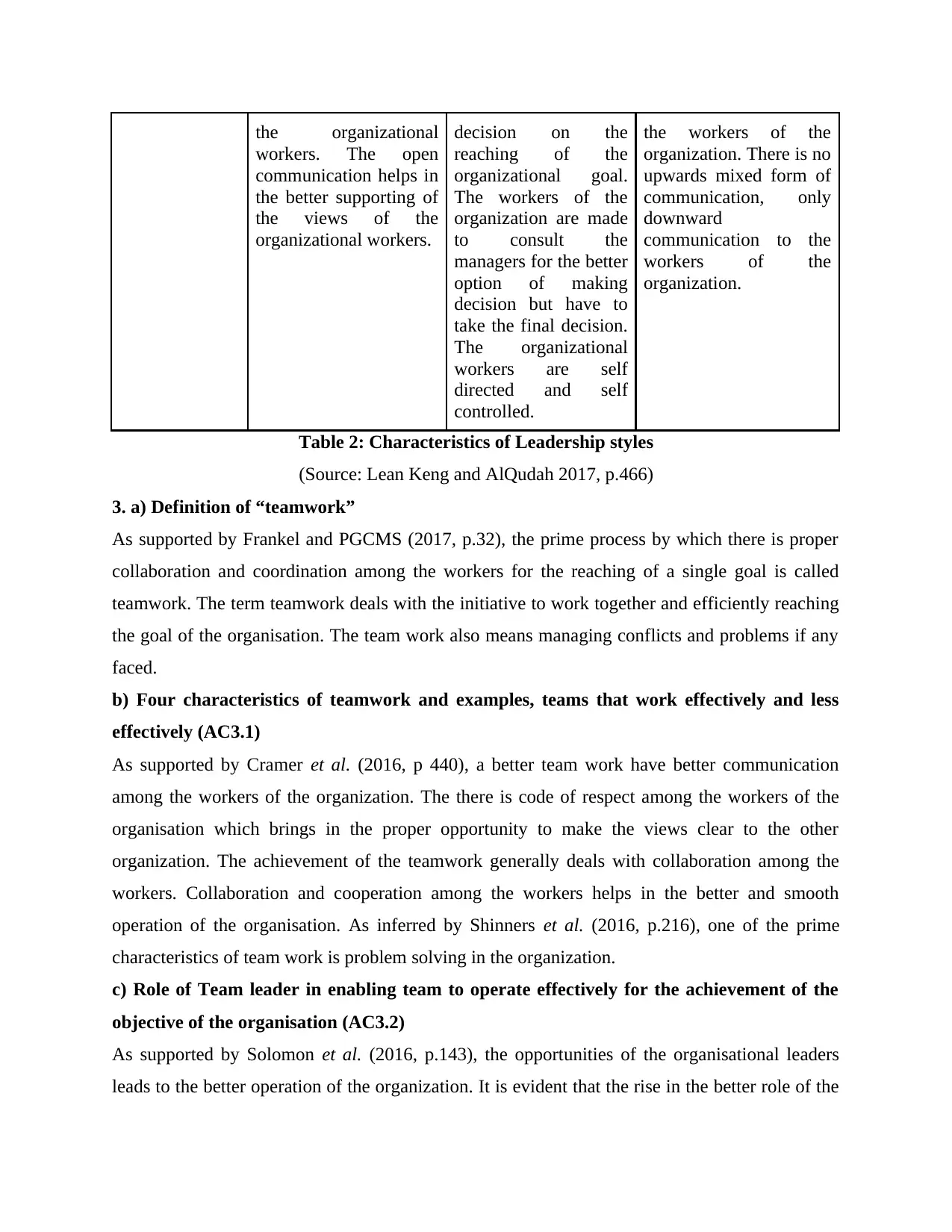
the organizational
workers. The open
communication helps in
the better supporting of
the views of the
organizational workers.
decision on the
reaching of the
organizational goal.
The workers of the
organization are made
to consult the
managers for the better
option of making
decision but have to
take the final decision.
The organizational
workers are self
directed and self
controlled.
the workers of the
organization. There is no
upwards mixed form of
communication, only
downward
communication to the
workers of the
organization.
Table 2: Characteristics of Leadership styles
(Source: Lean Keng and AlQudah 2017, p.466)
3. a) Definition of “teamwork”
As supported by Frankel and PGCMS (2017, p.32), the prime process by which there is proper
collaboration and coordination among the workers for the reaching of a single goal is called
teamwork. The term teamwork deals with the initiative to work together and efficiently reaching
the goal of the organisation. The team work also means managing conflicts and problems if any
faced.
b) Four characteristics of teamwork and examples, teams that work effectively and less
effectively (AC3.1)
As supported by Cramer et al. (2016, p 440), a better team work have better communication
among the workers of the organization. The there is code of respect among the workers of the
organisation which brings in the proper opportunity to make the views clear to the other
organization. The achievement of the teamwork generally deals with collaboration among the
workers. Collaboration and cooperation among the workers helps in the better and smooth
operation of the organisation. As inferred by Shinners et al. (2016, p.216), one of the prime
characteristics of team work is problem solving in the organization.
c) Role of Team leader in enabling team to operate effectively for the achievement of the
objective of the organisation (AC3.2)
As supported by Solomon et al. (2016, p.143), the opportunities of the organisational leaders
leads to the better operation of the organization. It is evident that the rise in the better role of the
workers. The open
communication helps in
the better supporting of
the views of the
organizational workers.
decision on the
reaching of the
organizational goal.
The workers of the
organization are made
to consult the
managers for the better
option of making
decision but have to
take the final decision.
The organizational
workers are self
directed and self
controlled.
the workers of the
organization. There is no
upwards mixed form of
communication, only
downward
communication to the
workers of the
organization.
Table 2: Characteristics of Leadership styles
(Source: Lean Keng and AlQudah 2017, p.466)
3. a) Definition of “teamwork”
As supported by Frankel and PGCMS (2017, p.32), the prime process by which there is proper
collaboration and coordination among the workers for the reaching of a single goal is called
teamwork. The term teamwork deals with the initiative to work together and efficiently reaching
the goal of the organisation. The team work also means managing conflicts and problems if any
faced.
b) Four characteristics of teamwork and examples, teams that work effectively and less
effectively (AC3.1)
As supported by Cramer et al. (2016, p 440), a better team work have better communication
among the workers of the organization. The there is code of respect among the workers of the
organisation which brings in the proper opportunity to make the views clear to the other
organization. The achievement of the teamwork generally deals with collaboration among the
workers. Collaboration and cooperation among the workers helps in the better and smooth
operation of the organisation. As inferred by Shinners et al. (2016, p.216), one of the prime
characteristics of team work is problem solving in the organization.
c) Role of Team leader in enabling team to operate effectively for the achievement of the
objective of the organisation (AC3.2)
As supported by Solomon et al. (2016, p.143), the opportunities of the organisational leaders
leads to the better operation of the organization. It is evident that the rise in the better role of the
⊘ This is a preview!⊘
Do you want full access?
Subscribe today to unlock all pages.

Trusted by 1+ million students worldwide
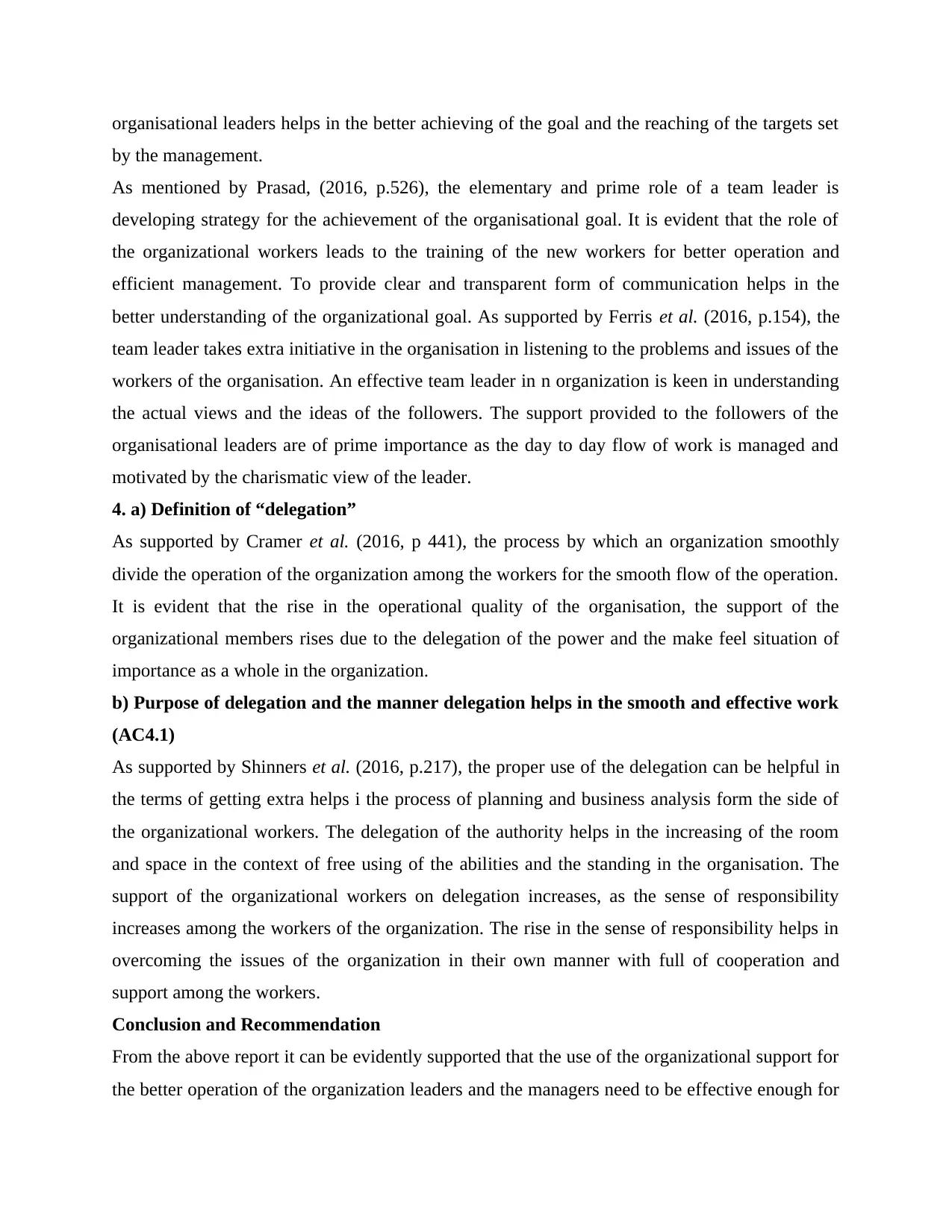
organisational leaders helps in the better achieving of the goal and the reaching of the targets set
by the management.
As mentioned by Prasad, (2016, p.526), the elementary and prime role of a team leader is
developing strategy for the achievement of the organisational goal. It is evident that the role of
the organizational workers leads to the training of the new workers for better operation and
efficient management. To provide clear and transparent form of communication helps in the
better understanding of the organizational goal. As supported by Ferris et al. (2016, p.154), the
team leader takes extra initiative in the organisation in listening to the problems and issues of the
workers of the organisation. An effective team leader in n organization is keen in understanding
the actual views and the ideas of the followers. The support provided to the followers of the
organisational leaders are of prime importance as the day to day flow of work is managed and
motivated by the charismatic view of the leader.
4. a) Definition of “delegation”
As supported by Cramer et al. (2016, p 441), the process by which an organization smoothly
divide the operation of the organization among the workers for the smooth flow of the operation.
It is evident that the rise in the operational quality of the organisation, the support of the
organizational members rises due to the delegation of the power and the make feel situation of
importance as a whole in the organization.
b) Purpose of delegation and the manner delegation helps in the smooth and effective work
(AC4.1)
As supported by Shinners et al. (2016, p.217), the proper use of the delegation can be helpful in
the terms of getting extra helps i the process of planning and business analysis form the side of
the organizational workers. The delegation of the authority helps in the increasing of the room
and space in the context of free using of the abilities and the standing in the organisation. The
support of the organizational workers on delegation increases, as the sense of responsibility
increases among the workers of the organization. The rise in the sense of responsibility helps in
overcoming the issues of the organization in their own manner with full of cooperation and
support among the workers.
Conclusion and Recommendation
From the above report it can be evidently supported that the use of the organizational support for
the better operation of the organization leaders and the managers need to be effective enough for
by the management.
As mentioned by Prasad, (2016, p.526), the elementary and prime role of a team leader is
developing strategy for the achievement of the organisational goal. It is evident that the role of
the organizational workers leads to the training of the new workers for better operation and
efficient management. To provide clear and transparent form of communication helps in the
better understanding of the organizational goal. As supported by Ferris et al. (2016, p.154), the
team leader takes extra initiative in the organisation in listening to the problems and issues of the
workers of the organisation. An effective team leader in n organization is keen in understanding
the actual views and the ideas of the followers. The support provided to the followers of the
organisational leaders are of prime importance as the day to day flow of work is managed and
motivated by the charismatic view of the leader.
4. a) Definition of “delegation”
As supported by Cramer et al. (2016, p 441), the process by which an organization smoothly
divide the operation of the organization among the workers for the smooth flow of the operation.
It is evident that the rise in the operational quality of the organisation, the support of the
organizational members rises due to the delegation of the power and the make feel situation of
importance as a whole in the organization.
b) Purpose of delegation and the manner delegation helps in the smooth and effective work
(AC4.1)
As supported by Shinners et al. (2016, p.217), the proper use of the delegation can be helpful in
the terms of getting extra helps i the process of planning and business analysis form the side of
the organizational workers. The delegation of the authority helps in the increasing of the room
and space in the context of free using of the abilities and the standing in the organisation. The
support of the organizational workers on delegation increases, as the sense of responsibility
increases among the workers of the organization. The rise in the sense of responsibility helps in
overcoming the issues of the organization in their own manner with full of cooperation and
support among the workers.
Conclusion and Recommendation
From the above report it can be evidently supported that the use of the organizational support for
the better operation of the organization leaders and the managers need to be effective enough for
Paraphrase This Document
Need a fresh take? Get an instant paraphrase of this document with our AI Paraphraser
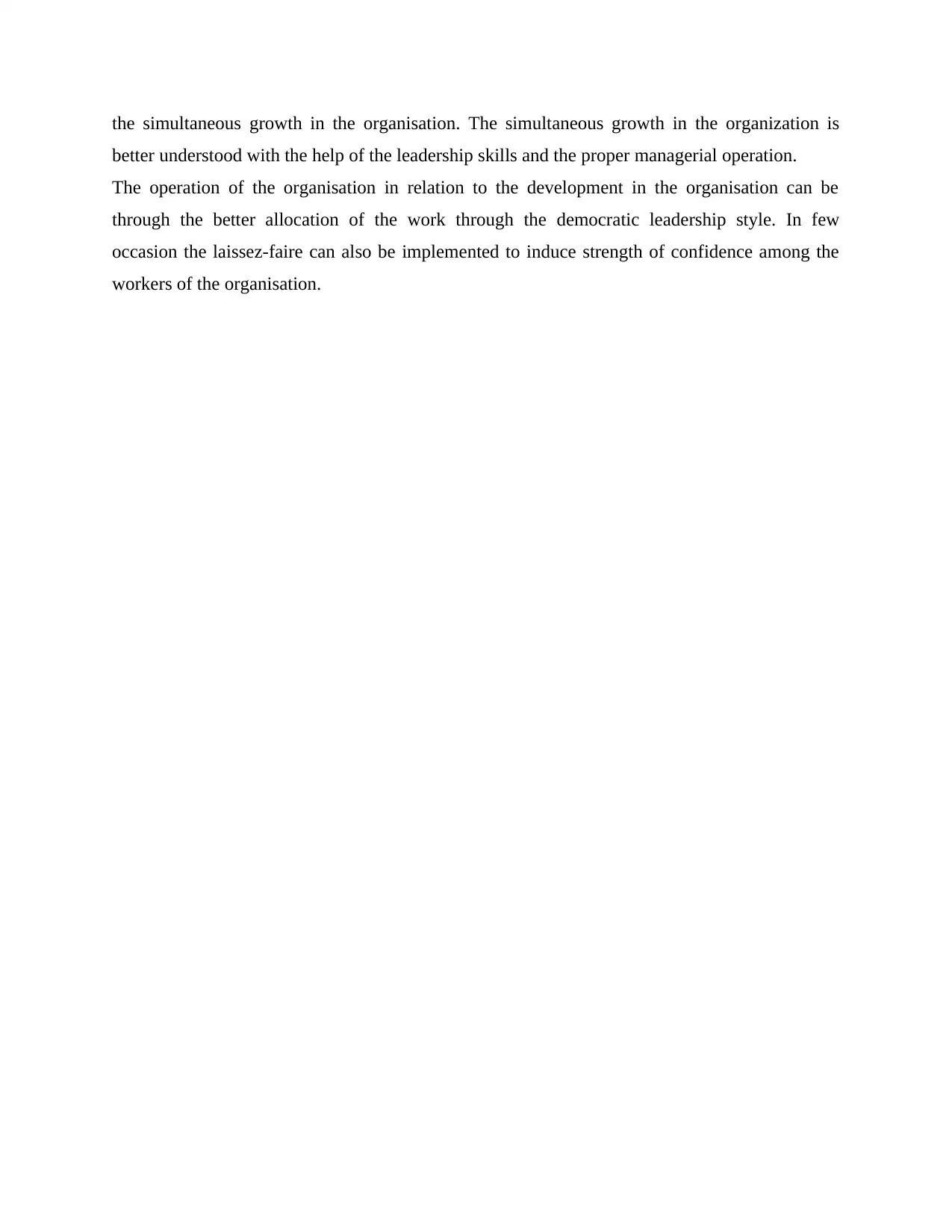
the simultaneous growth in the organisation. The simultaneous growth in the organization is
better understood with the help of the leadership skills and the proper managerial operation.
The operation of the organisation in relation to the development in the organisation can be
through the better allocation of the work through the democratic leadership style. In few
occasion the laissez-faire can also be implemented to induce strength of confidence among the
workers of the organisation.
better understood with the help of the leadership skills and the proper managerial operation.
The operation of the organisation in relation to the development in the organisation can be
through the better allocation of the work through the democratic leadership style. In few
occasion the laissez-faire can also be implemented to induce strength of confidence among the
workers of the organisation.
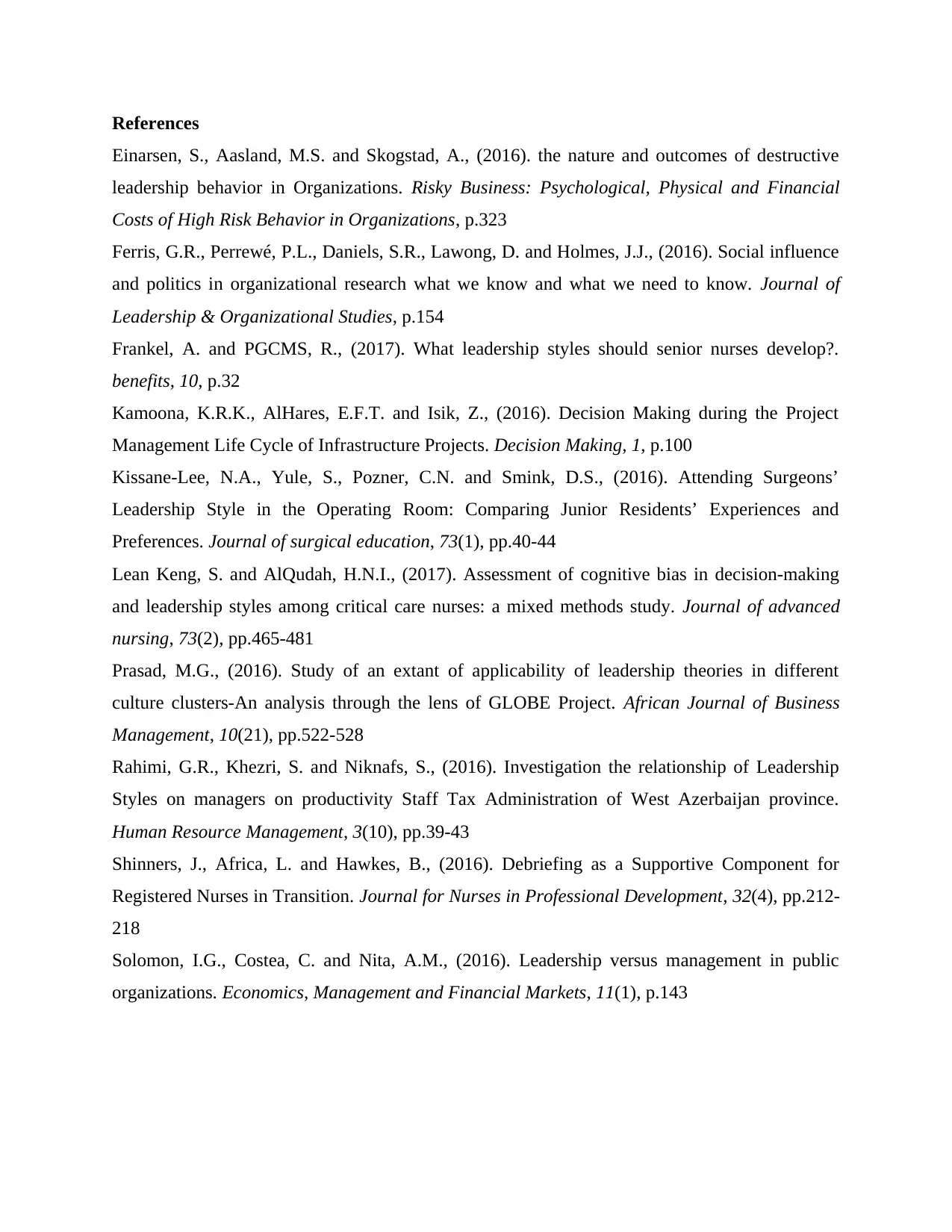
References
Einarsen, S., Aasland, M.S. and Skogstad, A., (2016). the nature and outcomes of destructive
leadership behavior in Organizations. Risky Business: Psychological, Physical and Financial
Costs of High Risk Behavior in Organizations, p.323
Ferris, G.R., Perrewé, P.L., Daniels, S.R., Lawong, D. and Holmes, J.J., (2016). Social influence
and politics in organizational research what we know and what we need to know. Journal of
Leadership & Organizational Studies, p.154
Frankel, A. and PGCMS, R., (2017). What leadership styles should senior nurses develop?.
benefits, 10, p.32
Kamoona, K.R.K., AlHares, E.F.T. and Isik, Z., (2016). Decision Making during the Project
Management Life Cycle of Infrastructure Projects. Decision Making, 1, p.100
Kissane-Lee, N.A., Yule, S., Pozner, C.N. and Smink, D.S., (2016). Attending Surgeons’
Leadership Style in the Operating Room: Comparing Junior Residents’ Experiences and
Preferences. Journal of surgical education, 73(1), pp.40-44
Lean Keng, S. and AlQudah, H.N.I., (2017). Assessment of cognitive bias in decision‐making
and leadership styles among critical care nurses: a mixed methods study. Journal of advanced
nursing, 73(2), pp.465-481
Prasad, M.G., (2016). Study of an extant of applicability of leadership theories in different
culture clusters-An analysis through the lens of GLOBE Project. African Journal of Business
Management, 10(21), pp.522-528
Rahimi, G.R., Khezri, S. and Niknafs, S., (2016). Investigation the relationship of Leadership
Styles on managers on productivity Staff Tax Administration of West Azerbaijan province.
Human Resource Management, 3(10), pp.39-43
Shinners, J., Africa, L. and Hawkes, B., (2016). Debriefing as a Supportive Component for
Registered Nurses in Transition. Journal for Nurses in Professional Development, 32(4), pp.212-
218
Solomon, I.G., Costea, C. and Nita, A.M., (2016). Leadership versus management in public
organizations. Economics, Management and Financial Markets, 11(1), p.143
Einarsen, S., Aasland, M.S. and Skogstad, A., (2016). the nature and outcomes of destructive
leadership behavior in Organizations. Risky Business: Psychological, Physical and Financial
Costs of High Risk Behavior in Organizations, p.323
Ferris, G.R., Perrewé, P.L., Daniels, S.R., Lawong, D. and Holmes, J.J., (2016). Social influence
and politics in organizational research what we know and what we need to know. Journal of
Leadership & Organizational Studies, p.154
Frankel, A. and PGCMS, R., (2017). What leadership styles should senior nurses develop?.
benefits, 10, p.32
Kamoona, K.R.K., AlHares, E.F.T. and Isik, Z., (2016). Decision Making during the Project
Management Life Cycle of Infrastructure Projects. Decision Making, 1, p.100
Kissane-Lee, N.A., Yule, S., Pozner, C.N. and Smink, D.S., (2016). Attending Surgeons’
Leadership Style in the Operating Room: Comparing Junior Residents’ Experiences and
Preferences. Journal of surgical education, 73(1), pp.40-44
Lean Keng, S. and AlQudah, H.N.I., (2017). Assessment of cognitive bias in decision‐making
and leadership styles among critical care nurses: a mixed methods study. Journal of advanced
nursing, 73(2), pp.465-481
Prasad, M.G., (2016). Study of an extant of applicability of leadership theories in different
culture clusters-An analysis through the lens of GLOBE Project. African Journal of Business
Management, 10(21), pp.522-528
Rahimi, G.R., Khezri, S. and Niknafs, S., (2016). Investigation the relationship of Leadership
Styles on managers on productivity Staff Tax Administration of West Azerbaijan province.
Human Resource Management, 3(10), pp.39-43
Shinners, J., Africa, L. and Hawkes, B., (2016). Debriefing as a Supportive Component for
Registered Nurses in Transition. Journal for Nurses in Professional Development, 32(4), pp.212-
218
Solomon, I.G., Costea, C. and Nita, A.M., (2016). Leadership versus management in public
organizations. Economics, Management and Financial Markets, 11(1), p.143
⊘ This is a preview!⊘
Do you want full access?
Subscribe today to unlock all pages.

Trusted by 1+ million students worldwide
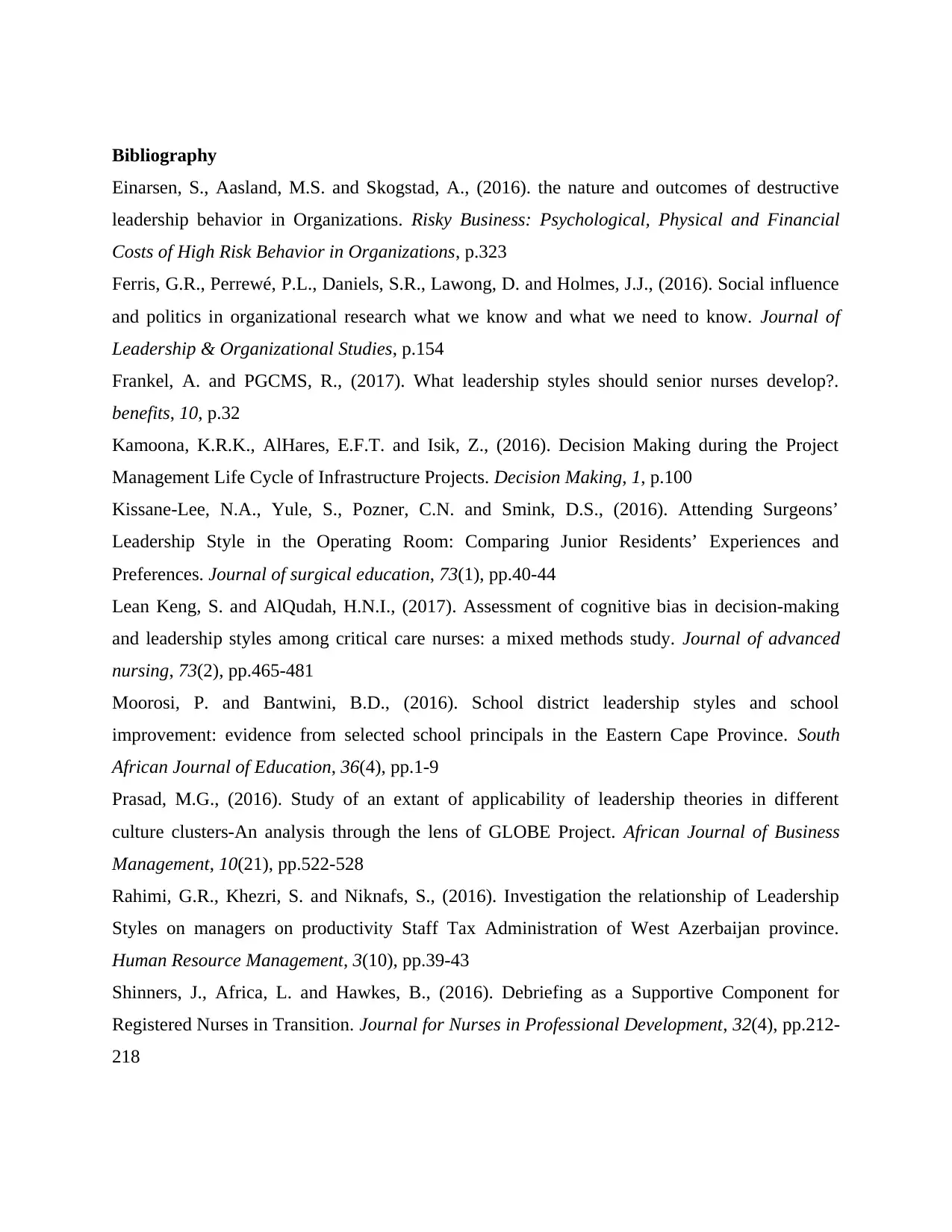
Bibliography
Einarsen, S., Aasland, M.S. and Skogstad, A., (2016). the nature and outcomes of destructive
leadership behavior in Organizations. Risky Business: Psychological, Physical and Financial
Costs of High Risk Behavior in Organizations, p.323
Ferris, G.R., Perrewé, P.L., Daniels, S.R., Lawong, D. and Holmes, J.J., (2016). Social influence
and politics in organizational research what we know and what we need to know. Journal of
Leadership & Organizational Studies, p.154
Frankel, A. and PGCMS, R., (2017). What leadership styles should senior nurses develop?.
benefits, 10, p.32
Kamoona, K.R.K., AlHares, E.F.T. and Isik, Z., (2016). Decision Making during the Project
Management Life Cycle of Infrastructure Projects. Decision Making, 1, p.100
Kissane-Lee, N.A., Yule, S., Pozner, C.N. and Smink, D.S., (2016). Attending Surgeons’
Leadership Style in the Operating Room: Comparing Junior Residents’ Experiences and
Preferences. Journal of surgical education, 73(1), pp.40-44
Lean Keng, S. and AlQudah, H.N.I., (2017). Assessment of cognitive bias in decision‐making
and leadership styles among critical care nurses: a mixed methods study. Journal of advanced
nursing, 73(2), pp.465-481
Moorosi, P. and Bantwini, B.D., (2016). School district leadership styles and school
improvement: evidence from selected school principals in the Eastern Cape Province. South
African Journal of Education, 36(4), pp.1-9
Prasad, M.G., (2016). Study of an extant of applicability of leadership theories in different
culture clusters-An analysis through the lens of GLOBE Project. African Journal of Business
Management, 10(21), pp.522-528
Rahimi, G.R., Khezri, S. and Niknafs, S., (2016). Investigation the relationship of Leadership
Styles on managers on productivity Staff Tax Administration of West Azerbaijan province.
Human Resource Management, 3(10), pp.39-43
Shinners, J., Africa, L. and Hawkes, B., (2016). Debriefing as a Supportive Component for
Registered Nurses in Transition. Journal for Nurses in Professional Development, 32(4), pp.212-
218
Einarsen, S., Aasland, M.S. and Skogstad, A., (2016). the nature and outcomes of destructive
leadership behavior in Organizations. Risky Business: Psychological, Physical and Financial
Costs of High Risk Behavior in Organizations, p.323
Ferris, G.R., Perrewé, P.L., Daniels, S.R., Lawong, D. and Holmes, J.J., (2016). Social influence
and politics in organizational research what we know and what we need to know. Journal of
Leadership & Organizational Studies, p.154
Frankel, A. and PGCMS, R., (2017). What leadership styles should senior nurses develop?.
benefits, 10, p.32
Kamoona, K.R.K., AlHares, E.F.T. and Isik, Z., (2016). Decision Making during the Project
Management Life Cycle of Infrastructure Projects. Decision Making, 1, p.100
Kissane-Lee, N.A., Yule, S., Pozner, C.N. and Smink, D.S., (2016). Attending Surgeons’
Leadership Style in the Operating Room: Comparing Junior Residents’ Experiences and
Preferences. Journal of surgical education, 73(1), pp.40-44
Lean Keng, S. and AlQudah, H.N.I., (2017). Assessment of cognitive bias in decision‐making
and leadership styles among critical care nurses: a mixed methods study. Journal of advanced
nursing, 73(2), pp.465-481
Moorosi, P. and Bantwini, B.D., (2016). School district leadership styles and school
improvement: evidence from selected school principals in the Eastern Cape Province. South
African Journal of Education, 36(4), pp.1-9
Prasad, M.G., (2016). Study of an extant of applicability of leadership theories in different
culture clusters-An analysis through the lens of GLOBE Project. African Journal of Business
Management, 10(21), pp.522-528
Rahimi, G.R., Khezri, S. and Niknafs, S., (2016). Investigation the relationship of Leadership
Styles on managers on productivity Staff Tax Administration of West Azerbaijan province.
Human Resource Management, 3(10), pp.39-43
Shinners, J., Africa, L. and Hawkes, B., (2016). Debriefing as a Supportive Component for
Registered Nurses in Transition. Journal for Nurses in Professional Development, 32(4), pp.212-
218
Paraphrase This Document
Need a fresh take? Get an instant paraphrase of this document with our AI Paraphraser
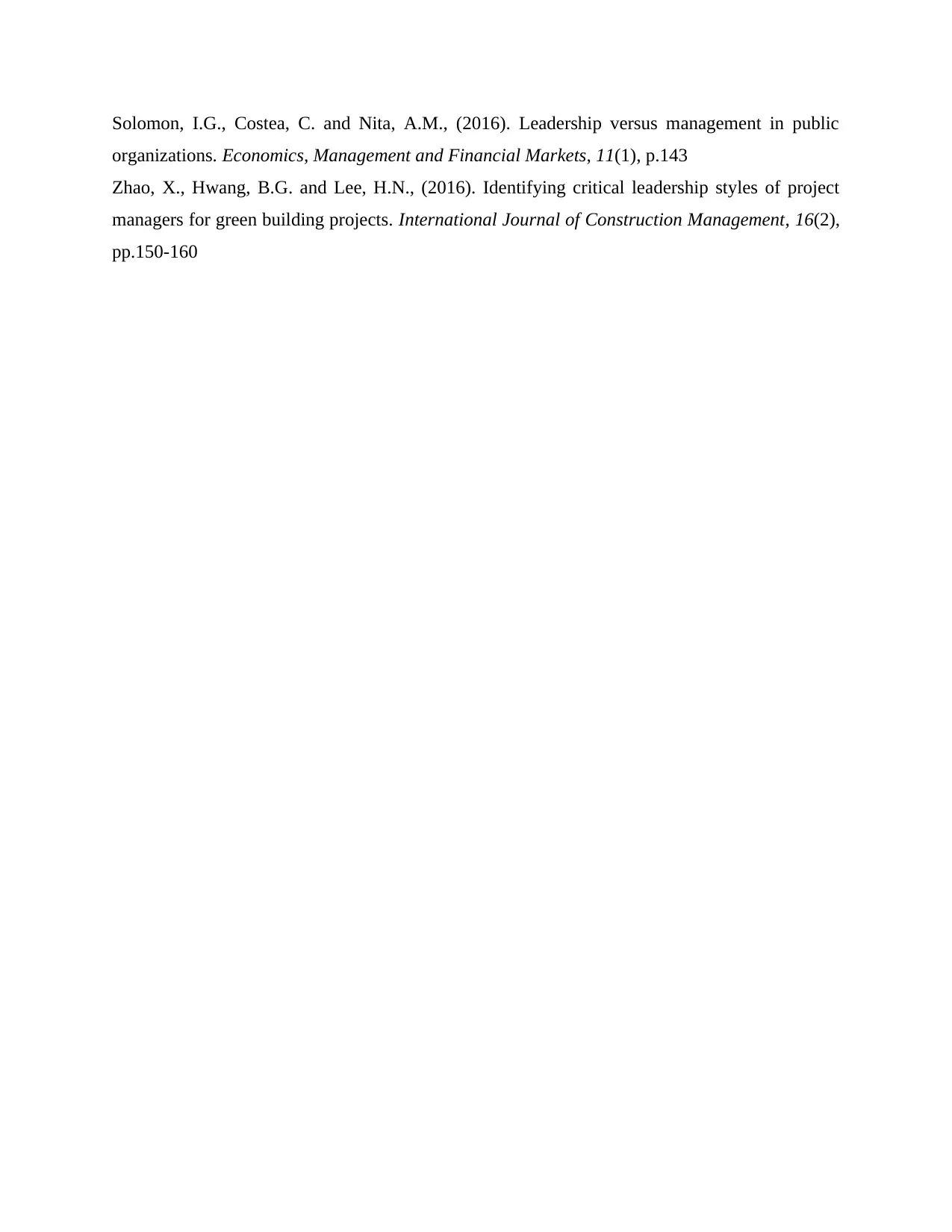
Solomon, I.G., Costea, C. and Nita, A.M., (2016). Leadership versus management in public
organizations. Economics, Management and Financial Markets, 11(1), p.143
Zhao, X., Hwang, B.G. and Lee, H.N., (2016). Identifying critical leadership styles of project
managers for green building projects. International Journal of Construction Management, 16(2),
pp.150-160
organizations. Economics, Management and Financial Markets, 11(1), p.143
Zhao, X., Hwang, B.G. and Lee, H.N., (2016). Identifying critical leadership styles of project
managers for green building projects. International Journal of Construction Management, 16(2),
pp.150-160
1 out of 11
Related Documents
Your All-in-One AI-Powered Toolkit for Academic Success.
+13062052269
info@desklib.com
Available 24*7 on WhatsApp / Email
![[object Object]](/_next/static/media/star-bottom.7253800d.svg)
Unlock your academic potential
Copyright © 2020–2025 A2Z Services. All Rights Reserved. Developed and managed by ZUCOL.





